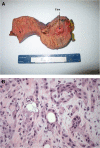Three synchronous, sporadic and separate periampullary and pancreatic tumors: more than a coincidence?
- PMID: 25494951
- PMCID: PMC4301858
- DOI: 10.1186/1477-7819-12-382
Three synchronous, sporadic and separate periampullary and pancreatic tumors: more than a coincidence?
Abstract
Three sporadic, synchronous, and separate lesions in the ampulla of Vater and the head of the pancreas presented in an 81-year-old male. One was symptomatic and two were incidental. One was detected preoperatively (the ampullary lesion) and two by examination of the resected specimen (the neuroendocrine and pancreatic carcinomas). The case is summarized and the literature and the issue of commonality are reviewed.
Figures




References
-
- Artac M, Bozcuk H, Ozdogan M, Demiral A, Sarpe A, Samur M, Sava B. Different clinical features of primary and secondary tumors in patients with multiple malignancies. Tumori. 2005;91:317–320. - PubMed
-
- Van Westreenen HL, Westerterp M, Jager PL, van Dullemen HM, Sloof GW, Comans EFI, van Lanschot JJB, Wiggers T, Plukker JTM. Synchronous primary neoplasms detected on 18F-FDG PET in staging of patients with esophageal cancer. J Nucl Med. 2005;46:1321–1325. - PubMed
-
- Crocetti E, Arniani S, Buiatti E. Synchronous and metachronous diagnosis of multiple primary cancers. Tumori. 1998;84:9–13. - PubMed
-
- Mehdi I, Shah AH, Moona MS, Verma K, Abussa A, Elramih R, El-Hashmi H. Synchronous and metachronous malignant tumours expect the unexpected. J Pak Med Assoc. 2010;60:905. - PubMed
Publication types
MeSH terms
LinkOut - more resources
Full Text Sources
Other Literature Sources
Medical

